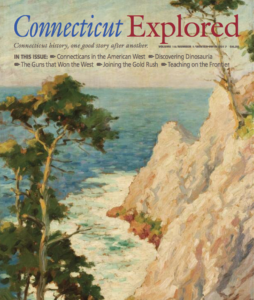By Walter W. Woodward
(c) Connecticut Explored, Inc. Winter 2016-2017
Many people know that Connecticans became pioneers of manifest destiny through their late-18th-into-early-19th-century emigrations west to Pennsylvania’s Wyoming Valley and Ohio’s Western Reserve. Fewer are aware that before Connecticans went west, many thousands migrated north, following the Connecticut River to what became the states of Vermont and New Hampshire. This northern migration, which historian Bruce C. Daniels in The Connecticut Town (Wesleyan University Press, 1979) says was the largest factor in our state’s relative population stagnation in the second half of the 1700s, both mirrored and set the stage for the better known diaspora that carried Connecticut settlers across the continent before 1850.
What drew Connecticans north before they went west was a desperate need for farmland. By 1750 most of the colony’s arable land had been farmed out. A rising generation faced an agrarian future offering ever-smaller, mostly infertile farms. Seeking greener pastures, they turned to the river that had long been the highway of Connecticut’s hopes and ambitions.
Connecticans had been creating new settlements north along the Connecticut River since the mid-1600s. But that painfully slow northern advance had been violently suppressed by 125 years of native resistance. The French and Indian War (1754-1763), in which 16,000 Connecticut militiamen saw service, gave many soldiers a first-hand look at the vast unsettled area. Even before the war ended, many rushed to acquire land grants. War’s end triggered a massive northern land rush.
These Connecticans brought their families, possessions, and town names with them: to Windsor, Windham, Orange, and Essex counties (among others) and to new towns named Guilford, Windham, Manchester, Wallingford, Brookfield, Roxbury, Norwich, Middlebury, Salisbury, Goshen, Bethel, and more. This desire to carry old Connecticut into the new land was so strong that 25 of the 211 Vermont town names appearing in the first census of 1790—about one out of every eight towns—was named after a Connecticut town of origin.
No family tried to make more of the new lands’ potential than the Litchfield County transplants known as the Allen Brothers. Ethan Allen—who would gain fame taking Fort Ticonderoga from the British at the start of the American Revolution—and his five brothers formed the Onion River Land Company in 1773. They cut roads and began selling farmsteads through ads in the Connecticut Courant. Within two years the company was reselling 65,000 acres in farmstead-size lots at a substantial profit.
To help its migrant sons and daughters remain on the straight and narrow path to heaven, Connecticut sent a steady stream of missionaries northward. Reverend Nathan Perkins of West Hartford toured the region in 1789 and, as described in a narrative published in 1920, saw the region as a diamond in the rough. Finding the settlers “low lived, indelicate and miserable cooks,” he realized they were “much more contented than in Hartford,” and he envisioned a glowing future. “In a few years [it will]be a good country, pleasant, and well to live in…. The body of ye people will be like Connecticut, and the land, take it together rather preferable to the land in our state—rather more feasible.”
Many Connecticans agreed. In fact, so many settlers migrated north that when the area’s leaders assembled to declare themselves, on January 15, 1777, to be “a free and independent jurisdiction, or state,” they also declared that they were forever hereafter to be “called known and distinguished by the name of New Connecticut, alias Vermont.”
Of course the name New Connecticut didn’t stick. After a decade or so of Vermont winters, Connecticans stopped moving north and began the journeys that would see Connecticut play a leading role in winning the West. Many of the skills that helped them on those journeys, though, had been acquired in Vermont, during the time when west was north.
Walter W. Woodward is the Connecticut state historian. Listen to his podcasts at Gratingthenutmeg.libsyn.com and visit his website at cthistory.org.

